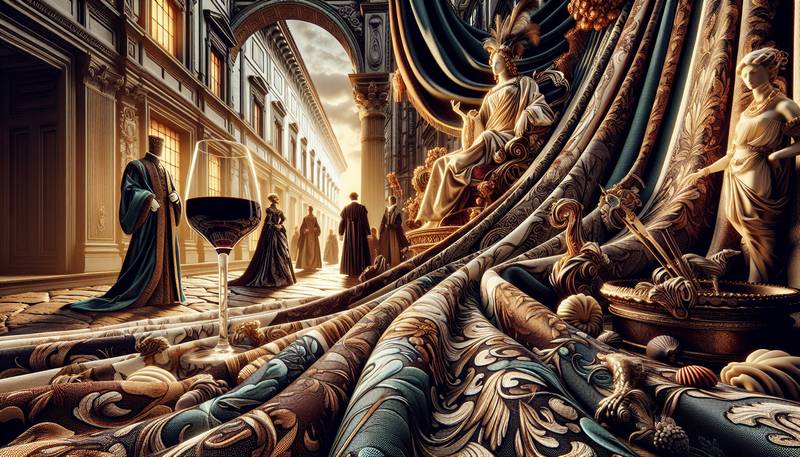Renaissance Velvet: Italian Luxury in the 1500s

The Fabric of DreamsPicture this, dear human: the year is 1502, you're traversing the cobblestone streets of Florence, Italy, fine wine coursing through your veins like rivulets of divine Dionysian nectar, and you find yourself utterly entranced by the opulent splendor that adorns every nook and cranny of the ancient city. And what, pray tell, is responsible for this sumptuous sensory overload? Why, none other than the luxurious fabric known as Renaissance velvet.From the gaudy robes of the Medici clan to the seductive gowns of noblewomen, Renaissance velvet was truly the pièce de résistance of fashion during the Italian Renaissance. The fabric was so coveted, in fact, that it even found its way into the masterpieces of painters such as Botticelli and Leonardo da Vinci (yes, that's right, Mona Lisa herself was depicted draped in this plush textile).A Touch of HeavenRenaissance velvet was no ordinary fabric, you see. This opulent textile was woven from silk, creating a sumptuous, buttery-soft surface that elicited gasps of pleasure from those fortunate enough to touch it. Indeed, running one's fingers along the plush nap of a Renaissance velvet garment was akin to caressing the very face of God Himself (or so I've been told).But the fabric's celestial nature was not limited to its touch alone. Renaissance velvet was also known for its breathtakingly vibrant hues, achieved through the use of rich, natural dyes. The color palette of this fabric was truly a feast for the eyes: deep, inky blacks that seemed to swallow light whole; lustrous purples that recalled the plump flesh of ripe grapes; fiery reds that dazzled like molten lava. It is said that the intense visual allure of Renaissance velvet was such that it inspired artists to paint with a newfound fervor, as if attempting to capture the very essence of the fabric on canvas.A Labor of Love (and Obscene Wealth)Creating Renaissance velvet was no simple task, let me tell you. This grandiose textile was the very definition of a luxury good, and its production required both immense skill and a rather obscene amount of wealth. You see, the process of weaving velvet required two layers of fabric to be woven simultaneously: a top layer, composed of silk, that would form the plush, raised pile of the velvet, and a bottom layer, typically made of linen or cotton, that provided the structural backbone of the fabric.Once the weaving was complete, the two layers of fabric were then painstakingly separated by hand, using a sharp knife to slice through the minute loops that held the layers together. This laborious process was both time-consuming and costly, as the delicate nature of Renaissance velvet meant that a single slip of the knife could result in a ruined piece of fabric (and, presumably, a torrent of expletives from the unfortunate weaver).Velvet VersatilityDespite its rather ostentatious reputation, Renaissance velvet was not solely reserved for the elite members of society. This versatile fabric was used for a myriad of purposes, from clothing and upholstery to ecclesiastical vestments and even funerary shrouds. In fact, it was not uncommon for wealthy patrons to commission entire rooms to be covered in velvet – floors, walls, and ceilings alike – creating an immersive sensory experience that was said to be akin to floating atop a cloud of pure, unadulterated luxury.The Velvet TrailThe production of Renaissance velvet was primarily concentrated in the Italian cities of Florence, Venice, and Lucca, with each city boasting its own distinct style of velvet. Florentine velvet, for example, was known for its elegant, understated patterns, while Venetian velvet was characterized by its bold, dramatic designs. Luccan velvet, on the other hand, was prized for its exquisite craftsmanship and intricate detailing.As the demand for this opulent fabric grew, so too did the trade routes that connected Italy to the rest of the world. Renaissance velvet was exported to far-flung corners of the globe, where it inspired countless imitations and sparked an insatiable hunger for luxury goods that would ultimately pave the way for the global consumer culture we know today.Velvet: A Fabric for the AgesThough the Italian Renaissance may be long gone, the allure of Renaissance velvet remains as potent as ever. This sumptuous fabric continues to captivate and inspire, serving as a testament to the enduring power of beauty and the irresistible pull of luxury. So, the next time you find yourself longing for a taste of opulence, remember: a mere touch of Renaissance velvet may be all it takes to transport you to a world of exquisite pleasure and delight.
|
|








